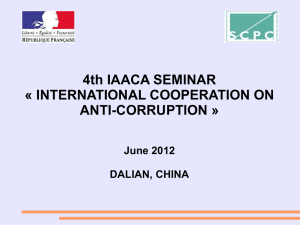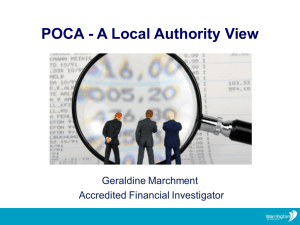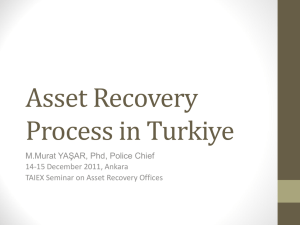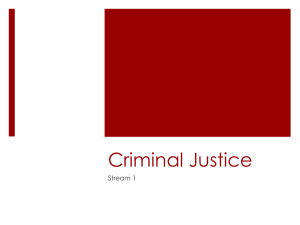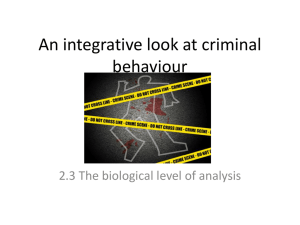Fraud and counterfeiting of non
advertisement
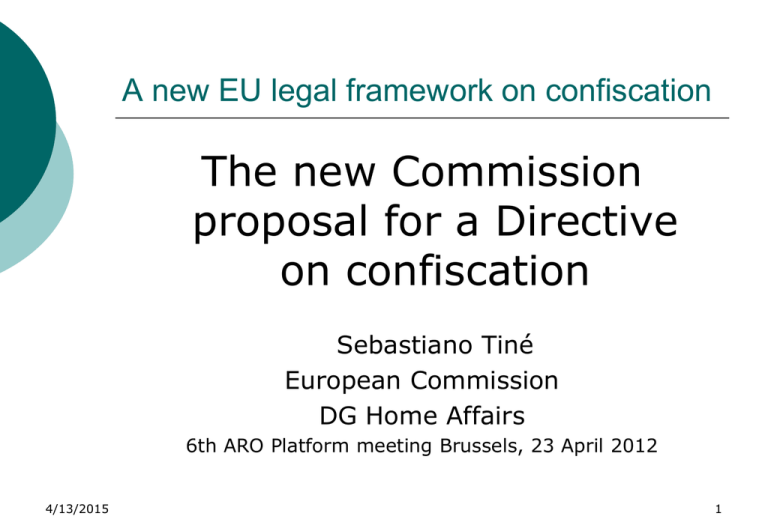
A new EU legal framework on confiscation The new Commission proposal for a Directive on confiscation Sebastiano Tiné European Commission DG Home Affairs 6th ARO Platform meeting Brussels, 23 April 2012 4/13/2015 1 Introduction – key features of EU legislation on confiscation 4/13/2015 The existing EU legal framework only applies to criminal proceedings and the issuance of confiscation orders generally requires a criminal conviction. Some Member States and third countries apply also non-conviction based (NCB) procedures, which have proven to be very effective in targeting criminal assets. There are no binding rules on NCB confiscation at EU level. There are no binding provisions at EU level on confiscating assets transferred to third parties. 2 The EU legislative framework Five EU instruments aim at ensuring a common approach to confiscation: 4/13/2015 Framework Decision 2001/500/JHA on money laundering, asset freezing and confiscation; Framework Decision 2003/577/JHA on the mutual recognition of freezing orders Framework Decision 2005/212/JHA on extended confiscation Framework Decision 2006/783/JHA on the mutual recognition of confiscation orders Council Decision 2007/845/JHA on Asset Recovery Offices 3 Framework Decision on Extended Confiscation (2005) 4/13/2015 Obligation to enable confiscation for offences providing deprivation of liberty for more than 1 year Aims at providing extended confiscation powers Minimum rules allowing confiscation for serious crimes (organised crime and terrorism) if offence generated financial gain Provides alternative criteria for extended confiscation (property derived from criminal activities; from similar criminal activities; value of property disproportionate to lawful income) Optional provisions on third party confiscation and non-conviction based confiscation Commission issued implementation report December 2007 highlighting shortcomings in implementation 4 Context of the proposal 4/13/2015 Organised crime is profit-driven and creates enormous illegal wealth every year. Estimates on the size of criminal profits in some Member States are very high (eg € 150 billion in Italy in 2011). Criminal groups operate across the borders and increasingly acquire and hide assets in other Member States. Compared to the estimated profits made from organised crime, the amounts confiscated in EU Member States remain modest. 5 Rationale for the proposal 4/13/2015 Extensive impact assessment study conducted in 2010-2011 Conclusion: Today's tools for freezing, managing and confiscating criminal assets are not effective enough. The current EU legal framework on confiscation and asset recovery is inadequate and still incompletely implemented. It has a narrower scope than the legislation in force in several Member States. More harmonisation is needed. 6 Policy context of the proposal 4/13/2015 Based on the Commission Communication on the proceeds of organised crime (2008) In line with the Stockholm Programme (2009) Responds to JHA Council Conclusions (June 2010) calling on the Commission to consider strengthening the EU legal framework. Announced in Commission Communication on a EU Internal Security Strategy (November 2010) Responds to the European Parliament Report on organised crime (2011), urging the Commission to propose new legislation. 7 Objectives of the Commission proposal 4/13/2015 Facilitate the confiscation of the proceeds of crime In particular the Directive aims at: attacking the financial incentive which drives most organised crime protecting the EU licit economy against infiltration by criminal groups returning criminal assets to governments and citizens. It draws on international Conventions and best practice recommendations. It aims at simplifying existing rules and filling gaps which have benefited criminals until now. 8 Scope (Art.2) 4/13/2015 Under the Lisbon Treaty substantive criminal law provisions at EU level can be adopted only for specific offences («the Eurocrimes») No longer possible to have EU provisions on confiscation which apply to all crimes The new Directive applies to specific serious offences already harmonised at EU level (eg drug trafficking, trafficking of human beings, sexual exploitation of children, money laundering, corruption, organised crime, cybercrime) 9 Extended confiscation (Art. 4) 4/13/2015 Clearer and more efficient rules to confiscate assets not directly linked to a specific crime Scope is now widened to all Eurocrimes harmonised at EU level Only one minimum criterion for extended confiscation (“similar criminal activities by the convicted person”) instead of the previous three alternative/cumulative criteria Less stringent burden of proof (from «court fully convinced» to «substantially more probable») Cases of exclusion of extended confiscation (previous acquittal, « ne bis in idem », prescription) 10 Non-conviction based confiscation (Art. 5) 4/13/2015 Possible in limited cases where a criminal conviction is not possible because the suspect is dead, permanently ill or is a fugitive Requires evidence that the person could have been convicted Directive leaves to Member States whether NCB procedures should be held in a criminal, administrative or civil court 11 Third party confiscation (Art. 6) 4/13/2015 Will mitigate the effects of the practice of transferring property to friends or relatives with a view to avoiding confiscation. Allows confiscation of assets transferred for less than market value by the suspect to a third party who should have realised that it is a result of crime. Also applies to licit assets transferred in order to avoid value confiscation Requires assessment that confiscation of the assets of the suspect is unlikely to succeed 12 Freezing (Art. 7) 4/13/2015 Introduces harmonised EU provisions enabling freezing in urgent cases Provides for precautionary freezing powers in urgent cases, for assets that risk disappearing if no action is taken Precautionary freezing powers can be exercised prior to seeking a court order or pending its request and are subject to confirmation by a court. 13 Effective execution of confiscation orders (Art. 9) 4/13/2015 Will allow the police and prosecutors to continue investigations on the assets of a convicted person when confiscation was ordered, but insufficient assets were confiscated. Measures can be taken to confiscate assets for the full amount of the unexecuted confiscation order This provision should prevent assets successfully hidden by criminals from “resurfacing” years later. and will stop criminals from ultimately enjoying their gains. 14 Safeguards (Art. 8) 4/13/2015 The proposal introduces safeguards at EU level in line with the EU Charter on Fundamental Rights (instead of making reference to national safeguards). Rationale: balancing far reaching confiscation measures with the respect of the right to property and other fundamental rights Safeguards aim at ensuring the respect of the presumption of innocence, the right to a fair trial, the existence of effective judicial remedies and the right to be informed on how to exercise them. 15 Asset Management (Art. 10) 4/13/2015 Objective: decreases in the value of assets frozen before confiscation should be avoided Requires Member States to have in place centralised (Asset Management Offices) or equivalent structures in order to properly manage frozen assets Requires Member States to grant to their national agencies the powers to realise frozen assets which are liable to decline in value 16 Other provisions 4/13/2015 Requires Member States to regularly collect statistics on freezing and confiscation and send them to the Commission annually The proposal does not fully replace former Framework Decisions (2001/500 JHA and 2005/212/JHA) in order to maintain the obligation for Member States to enable confiscation for any criminal offence 17 Next steps First reading of the proposal in Council expected under Danish Presidency of the Union Future Cypriot Presidency indicated this proposal as one of their priorities European Parliament is taking initial steps to prepare their report Sebastiano.Tine@ec.europa.eu 4/13/2015 18
